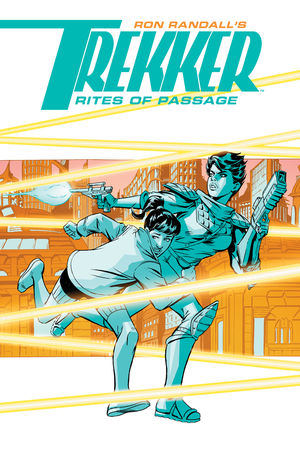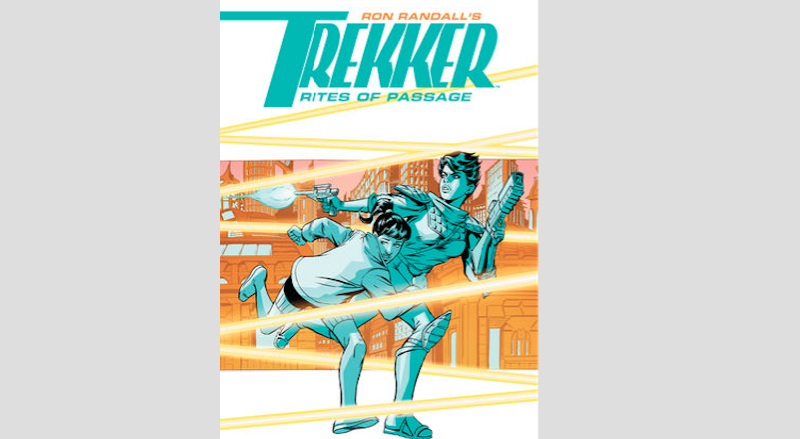INTERVIEW: Ron Randall fights off cyborg assassins to bring ‘Trekker’ to life

Ron Randall, the man behind the Trekker series and the new Trekker: Rites of Passage graphic novel, is a Renaissance man in the world of comics. He’s not only the artist for the successful series but also its writer and cover artist. He’s a dedicated and creative force who has brought the life of bounty hunter Mercy St. Clair to readers for decades.
In the new book, St. Clair has to safeguard a young woman who is on the run from cyborg assassins. Where they are headed and the mystery behind the young woman’s past are what drive Trekker: Rites of Passage from beginning to thrilling end. The book is now available from Dark Horse Comics.
This is the latest installment of St. Clair’s amazing journey. Fans might be surprised that the character first premiered in 1987, and, although the going has been rough, the bounty hunter keeps hunting and protecting.
Recently, Hollywood Soapbox exchanged emails with Randall about all things St. Clair. Questions and answers have been slightly edited for style.
Could you describe the early days of Trekker? How did the idea for this comic come about?
The early days of Trekker were also the early days of Dark Horse Comics.
I was working for DC on Warlord, a regular monthly title that I was penciling and inking, so I had a steady gig and a full work tray. But Mike Richardson and Randy Stradley introduced themselves to me at a local convention where I was a guest. They were starting a comics company and invited me to create something for them.
‘You can do anything you want,’ is the phrase as I remember it, and I couldn’t get that tempting offer out of my head. I figured I’d never hear that sentence again. So, I started to ask myself, if I could build a series from the ground up anyway I’d like to, what would that look like? Not trying to gear it to appeal to a particular audience or to persuade a particular publisher that it would fit a certain ‘commercial’ slot, but simply answering the question: ‘What’s my dream comic series’
And in answering that question I came up with Trekker: a science fiction action-adventure series that is about a complex, gifted young woman steeped in a world of violence who is on a big journey of discovery about the world and about herself.
I created the pitch, designed the character and sent a package off to Mike. It was, at the time, a pretty non-commercial concept on the face of it — a female-driven action-adventure series where she dresses appropriately for her job and keeps her clothes on. But I knew if I didn’t make it as believable and realistic as I could — within the bounds of a comic book, at least — I would lose interest in it myself.
It’s too much work to create and produce something like this if you don’t feel you are making something solid and worthwhile. And, ‘non-commercial’ though it was, Mike liked it and gave me the green light. I’m always grateful that Mike worked like that. If he saw a comic he thought was cool, he’d want to do it. I think we both thought, ‘Hey, I can’t be the only one out there who thinks this is cool.’
What are your favorite qualities of Mercy St. Clair?
I like that she is, to me, a believable character with depths, contradictions and a lot of stuff going on inside herself that she’s the last to know about. I like that she works as a kickass action bounty hunter, and that she works as a conflicted, questioning, thinking, feeling character whether she wants to be that or not. I like that she’s growing, learning, changing over the course of the series. It was designed like that from the beginning. That’s the point of Trekker, really. It’s a long form coming-of-age story disguised as a series of sci-fi action adventures.
How did you envision the world of New Gelaph?
I wanted to keep it simple at first, since I was new to the writing part of the job. So, I based the world of New Gelaph on the futuristic, gritty cities in a lot of sci-fi at the time. Blade Runner was a vivid example. I knew that the series would eventually take Mercy off-planet, and she’d grow to play a large role in the course of humankind out in the stars. But I knew I wasn’t yet the writer to do all that — to pull off that scale.
So, I first designed a series of smaller-scale action-centered stories that I felt I could keep a firm grip on and bring home solidly. Crime noir tales, a la Blade Runner, thinly veiled westerns with a sci-fi twist like Star Wars. That sort of thing. But eventually I wanted my own version of Dune or Foundation, with plenty of Flash Gordon still in the mix. So I peppered those early tales with references to the larger forces at work out there in the stars as a way to plant seeds for where I wanted to go eventually. The series is now at the point where all of that groundwork is starting to pay off.
Trekkerhas seen many different forms and issues over the years. What made you create a longer form graphic novel? What can your fans expect in Rites of Passage?
The formats have changed over time. And for Trekker, this graphic novel form, with flexibility to scale each story appropriately to its requirements, and keep each story under one cover, just fits the series best. I’ve always designed each tale to work as a stand-alone story. You can pick up any volume of Trekker and get a complete experience of that particular adventure. And, if you want to put the whole set of them together, that’s when you also get the bigger picture of the gradually expanding scale of things, and the arc of Mercy own long inner journey and evolution as well.
Rites of Passage is a big story. In scale, it’s the longest stand-alone story yet at 76 pages. And in content, it’s pivotal. It’s an epic, desperate journey. A deadly chase that begins on the streets of New Gelaph, travels through the stars and ends up on an alien planet, where the fate of a whole culture hangs in the balance. Along the way, Mercy faces shocking revelations about her past, and about the people she’s trusted the most. Her world view gets torn down and rebuilt, which points us to where the whole series goes from here on.
And because the little kid in me still loves the trappings of good science fiction tales, along the way there are also street fights, cyborg assassins, space ship crashes, alien cultures and swamp monsters. If Stan Lee wrote the ad copy, it would say, “This one’s got it all!!”
Do you feel you have accomplished your original goals for Trekker? Have you been surprised by how many adventures can be found for Mercy?
Trekker’s still a story in progress, so the ultimate goal won’t happen until I get to that last tale and have it come out with power, meaning and impact. I think I have a shot at getting there. I know now exactly what I’m after and a plan to get there. Beyond that it will all be in the execution, as it always is.
But in the meantime, yes — I think I’ve hit a lot of my original goals. I wanted to make a believable, compelling character, first and foremost. Otherwise, why would I care about the stories in any meaningful, emotional way? I wanted a strong, flawed character that would resonate for both female and male readers — someone they could relate to and respect. And I’ve been so gratified to have readers who remember the character vividly from those early stories as well, and newer readers, both women and men, who are just discovering the series now who come up to me and say how much the character and the stories work for them. That’s the best. I think the series and the character fit the comics and the cultural landscape now much better than they did when I launched the thing so recklessly all those years ago.
And no, I’m not surprised at how many adventures the series can contain. That’s one thing I love about sci-fi — you can tell just about any genre of story you want to, if you just take the right angle: a western? Sure: They are in the atomic wastelands instead of the barren plains. Horror? Sure: There’s a mutated monstrosity to defeat. Superheroes? Enhanced genetics augments a character, or artificial beings have special abilities. So that’s on the surface. And deeper, again, I designed Mercy to be a character with a lot going on inside her, and a lot of things to develop over time. That generates a lot of plots and stories to move the character forward incrementally on a personal journey.
It’s not always the case that an artist also writes their comics/graphic novels. Do you like this creative process in which you provide the story and artwork?
I love it. When I started, especially, it was incredibly hard and nerve-wracking. Because all the weight was suddenly on my shoulders alone, and it as all pretty new to me. But by now, I’ve been at it long enough and lived in Trekker‘s world long enough that I just can’t wait to get to the next tale. The next story coming up is always, always the best yet.
By John Soltes / Publisher / John@HollywoodSoapbox.com
Trekker: Rites of Passage is now available from Dark Horse Comics. Click here for more information.

